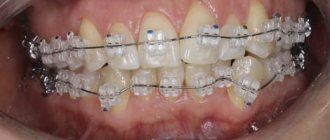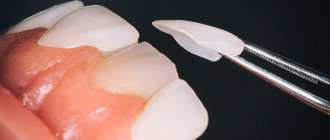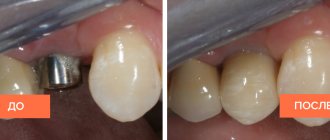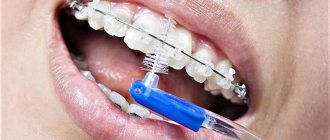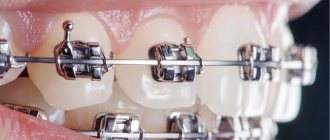In general, the period of wearing braces ranges from 1 to 3 years. But how to find out the exact timing? Orthodontic treatment involves more than just creating a beautiful smile. This also means restoring the functionality of the entire dentition. That's why the systems last so long. Bone and connective tissue are considered the densest. The pressure exerted on them to move must last for a long time. The optimal period is 1.5 years.
At a consultation appointment at the Propricus clinic, the orthodontist will first conduct an examination. This is necessary to assess the condition of the teeth and the entire dental system. Knowing the results, the orthodontist will be able to tell how long to wear braces.
How long does it take to install braces?
It is possible to answer exactly how long it will take to install braces for an adult or a teenager only after a preliminary consultation with a doctor. The fixation process itself usually takes 1-1.5 hours for any patient. Non-ligature structures are placed faster. Everything is purely individual and depends on each specific case.
However, it is first necessary to treat inflammatory processes in the mouth and have it professionally cleaned. Some designs are made individually, which also takes time: 1-2 weeks.
Oral preparation
The very first step before installing braces is a professional consultation with an orthodontist. The specialist examines the oral cavity, evaluates the teeth and gums. After this, he directs the patient to a panoramic photograph of the jaw. Having it in hand, the doctor receives a complete clinical picture and draws conclusions regarding the installation of orthodontic structures - whether it is advisable to prescribe the procedure in a particular case.
Braces are installed only on absolutely healthy teeth. Therefore, if the doctor identifies dental problems in the patient, they must first be eliminated. Treatment of caries may be necessary, including filling, and some other manipulations. Professional hygienic cleaning of the oral cavity is also required to remove plaque and tartar. Teeth must be clean and healthy before installing braces. Only after successful completion of the therapeutic process can the doctor prescribe the procedure.
How long do you wear traction on braces?
Rods (or rubber bands in other words) on brace systems are special rubber rings that are worn separately. Their purpose is to enhance the traction of the power arc to obtain faster and better correction results. The elastic bands are placed on the teeth approximately 4-5 months into orthodontic treatment. How long the braces are worn during the day depends on the clinical case: either 12 hours at night or around the clock.
Methods for attaching rubber bands:
- - on identical teeth of different jaws;
- - for 2 teeth in one jaw and 1 in the second;
- - square on 4 teeth (2 on top and 2 on bottom);
- - a combination of several options at once.
How long elastic bands are worn on braces is determined individually, but you need to plan for at least several months .
How long to wear elastic bands
Rubber bands are elastic bands. This is a small but very important detail. They are used at any stage of treatment. The principle of their influence is similar to an arc. They help guide the movement of the dentition or individual units. They are usually placed in the first six months of treatment. But it is not always the case. Elastics are used in the presence of impacted teeth. Rubber bands help the tooth quickly take its place in the row. In a distal bite, rubber bands pull the jaws closer to each other. The orthodontist decides whether to install traction bars or not. This is as important a tool as braces.
The principle of bite correction using a brace system
The classic system consists of directly braces (clasps), a power arch and ligatures. The clasps are fixed to the front surface of the teeth using an adhesive base. An arc is passed through them and secured with ligatures. In non-ligature designs, the arc clamps are already present on the clasps themselves.
The arch is the main element that ensures the movement of teeth. It is first given the “correct” shape, to which, thanks to the properties of the material, it tends to return. This ensures constant pressure on the teeth. As the periodontal ligaments and bone tissue gradually adapt to this traction, they become in the desired position.
FAQ
Why can’t I wear regular compression stockings during surgery?
Anti-embolic hosiery is designed specifically for hospital stays, so “regular” compression hosiery is not suitable for this purpose.
Hospital knitwear is white - this is necessary to monitor the condition of the veins during surgery. Regular compression knitwear does not have this color range. Hospital stockings have a special hole in the toe area, which is also necessary to monitor the patient’s condition.
Hospital knitwear has a certain knitting of threads, which allows you to stay in the products for a long time.
Is it true that hospital jersey is difficult to put on?
Yes it is. Also, not everyone can put on knitwear lying down. If you find it difficult to put on knitwear on your own, you can ask your relatives or medical staff for help.
What is the cost of anti-embolic jersey?
The better the quality of the knitwear, the higher its cost. The quality of knitwear is measured in the long-term preservation of compression properties. Also, a number of advantages can affect the cost: special knitting for a comfortable stay in the product, antibacterial properties, good fixation on the leg, and the like.
What factors affect wearing time?
- 1. Age. Bone tissue and ligaments in adolescents are more plastic, so eliminating bite problems of any complexity before the age of 18 requires an average of 3-6 months less time. This does not mean that complex defects cannot be corrected for an adult, but more time will have to be spent.
- 2. Complexity of the defect. The severity of the anomaly and its type also affect the timing of treatment. Even the most advanced cases of crowding are corrected faster than problems with jaw closure.
- 3. Type of system. The material and design of braces affect the timing. Non-ligature metal structures are the fastest to correct. Lingual ones take the longest, but they are invisible.
- 4. Doctor's experience. Optimal selection of the system, correct installation, control of tooth displacement - parameters that depend on the experience of the orthodontist. In our clinic, doctors are constantly improving their skills, so they can correct your bite in a minimum amount of time.
- 5. Patient compliance with recommendations. Following a diet and proper care of systems are also important. Damage to structures and the development of caries can cause a suspension of correction or a decrease in the effectiveness of treatment.
How to speed up the treatment process
Regular visits to the orthodontist are important. He must monitor the effectiveness of treatment and, if necessary, carry out correct timely correction.
The level of training of the dentist also has a serious impact on the result. Our clinic employs doctors with extensive experience who are able to correct even the most complex defects with minimal time.
Leave a request on the website or call us to schedule your first free consultation. We use many types of braces and guarantee the quality of treatment.
Type of braces and duration of treatment
Depending on the type of system, the duration of treatment varies:
- 1. Metal: the fastest and most effective.
- 2. Ceramic: due to fragility, they last a little longer than metal.
- 3. Sapphire: quite fragile, which increases the wearing period.
- 4. Lingual: the longest wearing period is 2-2.5 years, but the best aesthetics.
- 5. Self-ligating: on average 1-1.5 years.
- 6. Ligature: longer than non-ligature, but the exact period depends on the material.
Buy hospital knitwear →
See all
- Leader
Anti-embolic stockings Thrombexin 18 914
In stock
2,300 rub.
Buy
Code: 007853
medi, Germany
- Leader
Anti-embolic stockings Luomma Idealista 1 class ID-380
In stock
1,600 rub.
Buy
Code: 007848
LUOMMA IDEALISTA, Russia
- Leader
Anti-embolic stockings Luomma Idealista class 2 ID-380
In stock
RUR 2,400
Buy
Code: 010517
LUOMMA IDEALISTA, Russia
In stock
RUB 1,550
Buy
Code: 012636
LUOMMA IDEALISTA, Russia
In stock
RUB 3,950
Buy
Code: 007851
medi, Germany
In stock
from RUR 2,805
Buy
Code: 007854
TONUS ELAST, Latvia
In stock
RUB 1,925
Buy
Code: 007847
ERGOFORMA, Italy
In stock
RUB 1,710
Buy
Code: 007846
ERGOFORMA, Italy
- 20% discount
Anti-embolic PCI stocking up to the thigh, class 2, circular knit
In stock
550 rub. from 440 rub.
Buy
Code: 007862
LPP FARM, Russia
In stock
390 rub.
Buy
Code: 007863
LPP FARM, Russia
- 20% discount
Anti-embolic stockings Struva 23 917
In stock
RUB 3,500 from 2,800 rub.
Buy
Code: 007849
medi, Germany
In stock
RUB 2,350
Buy
Code: 007861
medi, Germany
Minimum and maximum wearing time
The average period of wearing braces is 1-1.5 years. You need to be prepared for this even before visiting the orthodontist. During the initial consultation, the doctor determines the specific duration of the correction, but the timing may change during the course of treatment.
The minimum period for wearing braces is 6 months. This usually applies to children with minor defects. But it is not possible to determine how long braces can be worn. Usually doctors talk about 2.5-3 years. The known record of correction by the system: 9 years and 8 months.
How long should children wear braces?
The child’s dentofacial apparatus is easier to correct even in difficult clinical situations. Therefore, the duration of correction is significantly less than for an adult. 12-16 years old needs to wear braces can only be found out at an appointment with an orthodontist, but rarely longer than 2 years .
How long should adults wear braces?
The dental system of an adult is much less susceptible to external influences. There are several reasons for this:
- 1. The dentofacial apparatus is fully formed.
- 2. Bone tissue is denser.
- 3. Restorative processes in tissues are slowed down.
- 4. The speed of any exchange processes is reduced.
18-30 should wear braces . Even minor defects may require treatment for 1.5-2 years. Advanced cases can take 3 or more years to resolve.
What are compression garments and why are they needed?
Compression stockings belong to the group of therapeutic and prophylactic products that are made from special innovative materials that provide an anti-embolic effect. Before the advent of stockings, compression was achieved through the use of elastic bandages. Unlike the latter, compression stockings, which can be bought today in almost any specialized store, have significant advantages, practicality in use and a longer service life.
Compression stockings are needed to provide support to weakened veins and muscles. Due to graduated compression technology, compression products increase blood outflow and normalize general blood circulation, preventing the formation of blood clots.
The advantages of compression stockings are as follows:
- High-quality support for venous and vascular walls;
- Activation of blood circulation in the lower extremities;
- Prevention of further expansion of veins;
- Support muscle tone and soft tissue;
- Reducing pain, heaviness and fatigue in the legs;
- Prevention of cramps in the calf muscles;
- Treatment and prevention of spider veins.
When can you remove braces?
The process of occlusion correction consists of several stages; the structures can be removed after completion of the last one. First, the teeth are aligned along the arch, then the main formation of the bite occurs (the teeth are moved forward or backward, gaps are removed, the position of the jaws is corrected), and finally minor defects are eliminated. An orthodontist removes braces in a dental office.
In some cases, braces have to be removed ahead of schedule:
- - development of inflammatory processes in the oral cavity;
- - allergic reaction to elements of the system (most often to metal);
- - poor oral hygiene;
- - the need for surgery to correct the bite.
If possible, after removing the treatment limitation, the system is reinstalled. Otherwise, an alternative method of orthodontic treatment is selected.
How to care for medical knitwear?
As for the rules for caring for compression hosiery, the following can be distinguished:
- It is recommended to wash anti-embolic stockings daily, as dust, sweat, and dead skin cells accumulate between the elastic fibers every day. This may cause an unpleasant odor;
- It is best to use mild, non-aggressive agents as cleaning agents. This could be baby soap or specialized preparations for washing such products;
- Anti-embolic compression stockings should only be washed by hand. Otherwise, the product may lose its therapeutic and prophylactic properties;
- When washing, it is also extremely important to maintain the water temperature. Medical knitwear cannot be boiled, wrung out or dried on a horizontal surface.
- When putting on products, be sure to remove rings, bracelets and any other accessories from your fingers that could damage the structure of the compression garment.
Proper care of medical compression hosiery will help increase the service life of the product, as well as preserve its therapeutic and preventive properties.
How to choose the right anti-embolic compression stockings?
It is very important, before purchasing anti-embolic stockings, to choose the correct size. For the product to bring maximum benefit, it must fit well on the foot and provide optimal compression. A stocking that fits too tightly can interfere with circulation, and too little compression will do no good. To choose the right size of compression stockings, you need to measure the volume of the limb in three zones: in the hip area, in the lower leg area and in the ankle area. Based on the three parameters obtained, the required product size is selected. You can find all sizes with their corresponding measurements in the table from the manufacturer, which is presented by brands of compression products.
We can note that brands that have proven themselves quite well in the market include the following companies: Medi (Germany), Aurafix (Turkey) and Belsana (Germany). These brands produce high-quality compression knitwear, which is in particular demand among buyers and is included in the affordable price segment. The price-quality ratio of these brands can be considered more than satisfactory, so the products have earned trust in the European market.
How long do you wear retainers after braces?
Fixed retainer
Orthodontic treatment does not end after the braces are removed. Consolidating the correction result requires wearing special mouthguards (retainers). They fix the teeth in the correct position and prevent them from returning to their original incorrect position under the influence of chewing loads.
Retainers are removable and non-removable . The first ones are removed during meals, are noticeable and require self-discipline. The second ones are fixed and removed by a doctor and are not visible to others. As a rule, the patient is first prescribed permanent wearing of non-removable plates. Then he switches to using removable ones around the clock, gradually starting to wear them only at night.
Removable retainer
The orthodontist decides how long to wear the retainer after braces are removed. On average, the time it takes to consolidate the results with mouth guards is 2-3 times longer than the duration of the treatment itself: 3-6 years . For adults with corrected advanced malocclusions, retainers may be recommended for life.
Posted by:
Features of compression stockings after surgery
Products that are used in the pre- and postoperative period are called “anti-embolic”, and are used for speedy rehabilitation, as well as in preparation for surgical interventions. Anti-embolic products are made from hypoallergenic materials and include an absolute absence of seams. Visually, compression products are practically no different from ordinary hosiery, and also have good breathability and do not cause discomfort while wearing.
The main difference between compression underwear and ordinary hosiery is the material from which they are made. Medical knitwear is made of special highly elastic fabric, which exerts graduated pressure on the veins. The compression provided by the products is distributed according to the characteristics of the anatomical structure of the human body, that is:
- In the hip area, compression is about thirty to forty percent;
- Medium height zone (knees, shins) - up to seventy percent of the total compression force;
- Ankle area – maximum 100% compression.
This distribution is necessary in order to achieve the maximum therapeutic and prophylactic effect. This is due to the characteristics of the blood flow, which moves towards the heart muscle.
What is the bite like?
Bite (occlusion) is the position of the lower and upper dentition relative to each other when closing. We are talking not only about the position of the teeth, but also the joints and muscles during speech and chewing.
The bite can be normal (physiological), when the teeth close evenly or incorrectly.
How long it will take to correct a bite with braces largely depends on the type of violation of the normal closure of the teeth. The main types of abnormal bite that may require correction with braces include:
- distal;
- open;
- mesial;
- deep;
- cross.
Let's look at each type of bite in more detail. This will help you better understand why in some cases it is necessary to wear braces for a long time.

